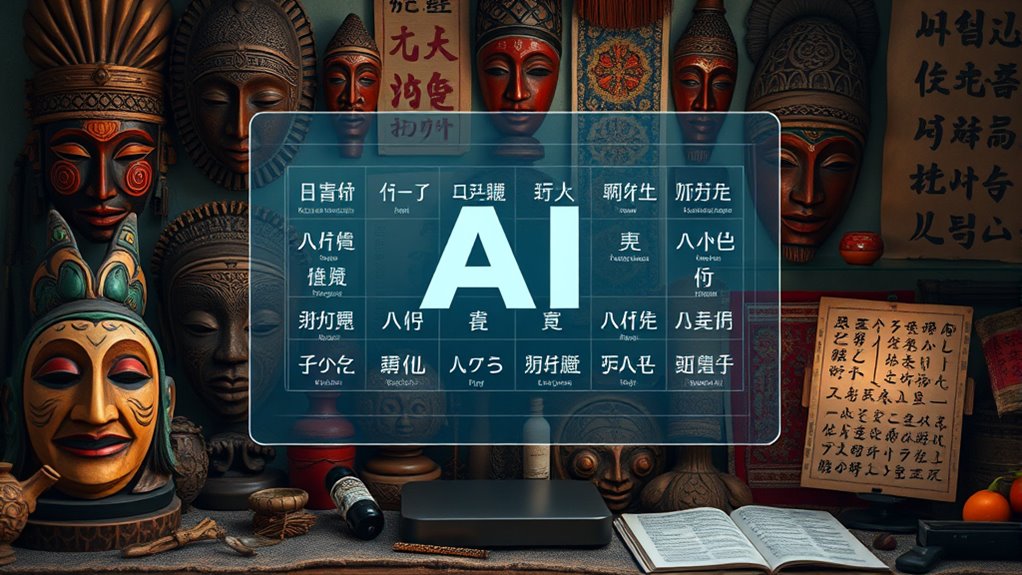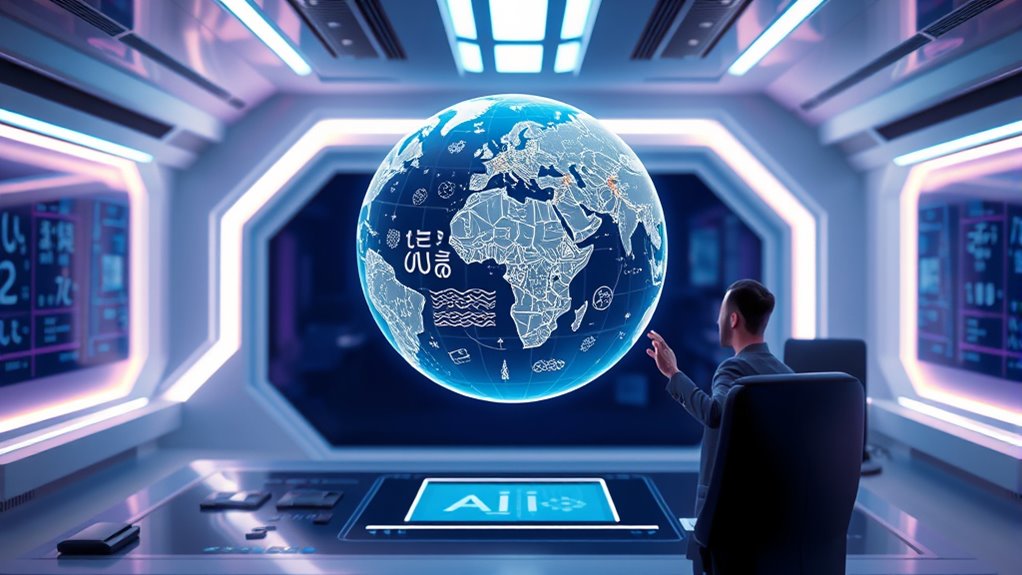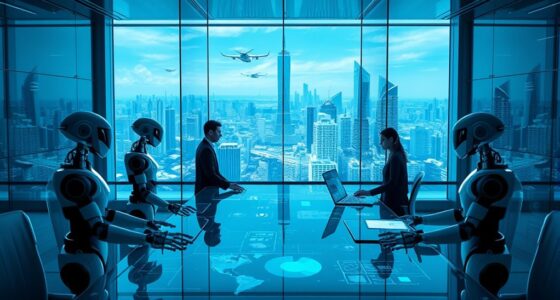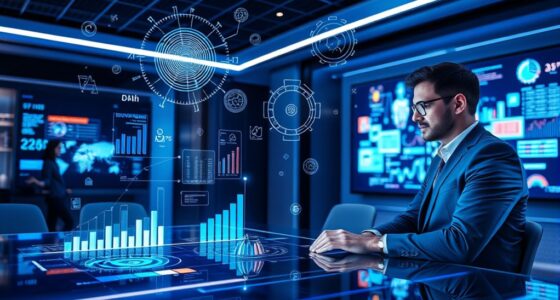Artificial intelligence is making impressive progress in understanding and translating cultural nuances. Using advanced techniques like Graph Neural Networks and cultural metadata, AI can now better grasp idioms, humor, and emotional undertones across diverse languages. While AI improves speed and consistency, human expertise remains crucial for capturing subtle cultural context and avoiding misinterpretations. To discover how ongoing innovations are shaping AI’s cultural fluency and what challenges still lie ahead, explore further insights.
Key Takeaways
- Advances like Sony AI’s Graph Neural Networks enable AI to interpret idioms and cultural references across languages.
- Incorporating cultural metadata into models enhances AI’s understanding of context and emotional nuance.
- AI systems can adapt to new idioms through shared cultural concepts, improving translation accuracy.
- Combining AI with human expertise ensures precise, culturally sensitive translations for complex content.
- Ongoing research aims to elevate AI’s ability to capture cultural nuance with increasing precision.

Have you ever wondered if artificial intelligence can truly capture the subtlety of cultural nuance in translation? It’s a challenging feat because cultural nuance involves unspoken norms, emotional undertones, and context that go far beyond literal words. Idiomatic expressions and humor are particularly difficult for AI because they are deeply rooted in specific cultural references. When AI translates these, it often produces awkward or inaccurate results, which can lead to misunderstandings or even offend the target audience. Tone differences, like casual versus formal language, also require cultural adaptation that current AI models struggle to handle naturally. If AI mishandles these nuances, it risks damaging brand reputation and eroding trust in global markets. To address this, AI systems need a deep understanding of cultural frameworks and local variations, which remains a major challenge for existing models.
That said, advances are happening. For example, Sony AI’s IdiomCE uses Graph Neural Networks to map idioms across Indian languages by linking them through shared concepts, values, and historical contexts rather than literal translation. This approach allows the system to adapt to idioms it hasn’t encountered before, improving coverage and capturing more nuance. Incorporating cultural metadata into machine learning models helps enhance contextual understanding, especially in linguistically diverse regions with low resources. These innovations aim to bridge the gap between literal translation and cultural relevance, but they’re still in development. Additionally, ongoing research emphasizes the importance of cultural adaptability to make AI translation more effective across different regions.
Sony AI’s IdiomCE leverages Graph Neural Networks to adapt idioms across Indian languages through shared cultural concepts.
You should understand that human translators play a crucial role in capturing cultural subtleties AI cannot yet fully grasp. They bring lived cultural experience, steering idiomatic and metaphorical language with ease and ensuring that messages resonate authentically. Relying solely on AI risks miscommunication and could harm relationships, especially in sensitive or high-stakes contexts. That’s why combining AI’s speed with human expertise yields the best results—AI handles volume and basic tasks, while humans refine and localize content to fit cultural expectations.
While AI offers speed and cost advantages, it still struggles with idioms, metaphors, and legal nuances. Human translators excel at conveying tone and cultural context, making them indispensable for high-accuracy, sensitive content. Ongoing research aims to improve AI’s cultural understanding, but for now, the most effective approach is to see AI as a tool that complements, not replaces, human insight in translation. Furthermore, understanding that cultural norms evolve over time is crucial, as static datasets may become outdated, leading to inaccuracies or insensitivity.
Frequently Asked Questions
How Does AI Understand Cultural Context Beyond Language?
You want to know how AI understands cultural context beyond language. AI analyzes behavioral patterns, social cues, and cultural values by studying communication styles, gestures, and idioms. It recognizes differences in tone, humor, and nonverbal signals, adapting responses accordingly. By continuously learning from diverse user feedback and incorporating cultural insights, AI refines its understanding, helping it interpret and respond more accurately across various cultural situations.
Can AI Adapt to Evolving Cultural Norms Over Time?
Yes, you can see AI adapt aptly to changing cultural cues. By leveraging learning from lively, layered social interactions and simulated scenarios, AI continuously updates its understanding. You guide this growth through prompt-based inputs and feedback, fostering flexibility. With ongoing data collection and cross-disciplinary collaboration, AI becomes more responsive, refining responses to reflect evolving norms, ensuring it stays sensitive, sophisticated, and synchronized with shifting societal standards over time.
What Are the Limitations of AI in Capturing Cultural Subtleties?
You might think AI captures cultural subtleties perfectly, but it actually struggles with this. It often misses context, idioms, and emotional nuances that are crucial for true understanding. Cultural biases from training data can lead to insensitive translations, and AI lags behind evolving norms. You should know that complex humor, sarcasm, and high-stakes language still require human insight, making AI’s grasp of cultural subtleties imperfect and limited.
How Does AI Handle Idioms and Slang From Different Cultures?
A stitch in time saves nine. When you ask how AI handles idioms and slang, you’ll find it analyzes context and adapts translations to maintain meaning and tone. It uses advanced NLP techniques and regional data to interpret idiomatic expressions, but struggles with dialects, code-switching, and deep cultural nuances. Human oversight remains essential to guarantee the translations capture authentic cultural subtleties that AI alone might miss or misinterpret.
Is There a Risk of AI Reinforcing Cultural Stereotypes?
Yes, there’s a real risk that AI reinforces cultural stereotypes. You might find that AI models reproduce biased portrayals, racial or gender stereotypes, or language judgments rooted in societal prejudices. These biases often stem from training data reflecting existing stereotypes, which AI then amplifies unintentionally. As a user, you should be aware of this, especially when AI influences decision-making, education, or media, and advocate for more responsible, bias-mitigating AI development.
Conclusion
As you see, artificial intelligence is like a bridge spanning cultural divides, not just a translator of words but a curator of nuance. It’s proving that technology can dance gracefully with the delicate threads of tradition and context, turning language into a shared tapestry. While challenges remain, AI’s ability to grasp cultural subtleties is a beacon of hope, illuminating a future where understanding flows as naturally as a river carving its path through diverse landscapes.









